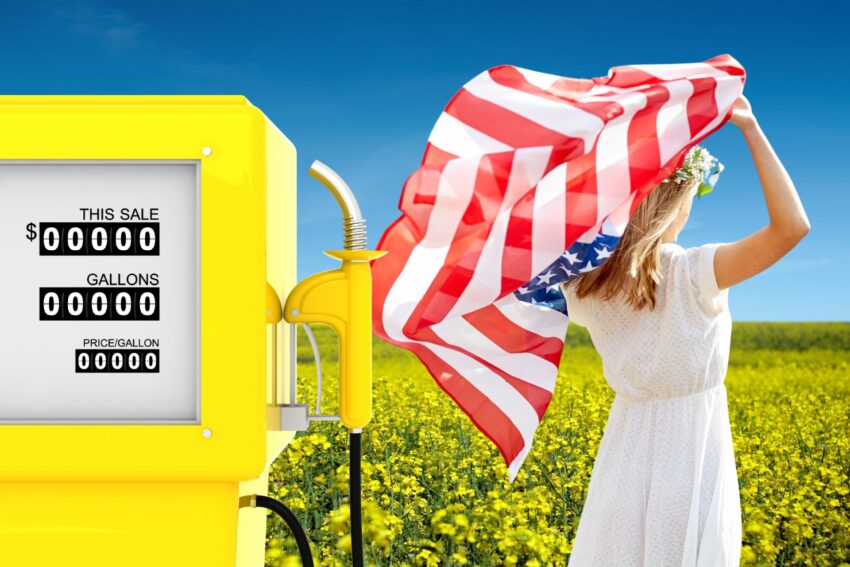You may have noticed that at AgroWars we are extremely skeptical about many recent “green” initiatives, but as you may already know, biofuels are nothing new and should have been adopted long ago, were it not for the substantial influence of oil cartels. While politicians push us to run our cars and machinery on expensive electric batteries that come along with a whole host of problems, we should instead be looking to a future where our fuel is grown here at home.
As the global energy landscape continues to evolve, biofuels have emerged as a promising solution to enhance energy independence, reduce gas prices, minimize the influence of big oil and Saudi Arabia, and support American farmers. Biofuels, derived from renewable biomass sources such as corn, sugarcane, and canola, offer a sustainable alternative to fossil fuels, which can be produced domestically and help reduce the nation’s reliance on crude oil.
One of the most significant advantages of biofuels is their potential to lower gas prices. As the United States increases its biofuel production, it can reduce its dependence on imported oil, which often fluctuates in price due to geopolitical tensions and market volatility. Biofuels can provide a stable, domestic source of energy, which can help stabilize gas prices and protect consumers from price shocks. Additionally, as more biofuels enter the market, competition among fuel providers can lead to lower prices at the pump.
By increasing the use of biofuels, the United States can also diminish the influence of big oil companies and reduce its reliance on oil from countries like Saudi Arabia. Biofuels are produced domestically, which means that the profits from their production stay within the country, supporting local economies and creating jobs. This shift can help break the stronghold that big oil companies have on the energy market and allow the United States to pursue a more independent energy policy.
Another critical benefit of increasing biofuel production is supporting American farmers. Farmers can grow crops specifically for biofuel production, creating a new market for their products and providing a stable source of income. This can help revitalize rural communities and support the agricultural sector, which is a vital part of the American economy.
Engine adaptation is another crucial aspect of the biofuel revolution. While older engines may require some modifications to run efficiently on biofuels, modern engines are increasingly designed to be compatible with biofuels. In fact, many car manufacturers now produce “flex-fuel” vehicles that can run on gasoline, ethanol, or a mixture of both. These engines can seamlessly switch between different fuel types, making it easier for consumers to transition to biofuels.
For older engines, modifications can be relatively inexpensive. For example, a simple fuel system upgrade, such as installing a new fuel pump or fuel injectors, can allow an engine to run efficiently on biofuels. In some cases, adjusting the engine’s timing and air-fuel mixture can also improve performance and fuel efficiency. These modifications are generally affordable and can be easily performed by a qualified mechanic. Some people argue that these modifications could have been put into cars long ago, were it not for the undue influence of oil companies.
What some people might not know is that the first internal combustion engines ran on ethanol and that Henry Ford was a big proponent of biofuels. However, he didn’t just stop at wanting our fuel to come from American-grown plants, but he also envisioned our cars being “grown” here at home as well. He saw hemp as one of the big crops to lead us into a sustainable, independent future.
“Why use up the forests, which were centuries in the making, and the mines, which required ages to lay down, if we can get the equivalent of forest and mineral products in the annual growth of the hemp fields?” ~ Henry Ford
From Henry Ford’s Hemp Cars:
Ford’s 1941 bioplastic Model T was made of hemp, flax, wheat, and spruce pulp, which made the car lighter than fiberglass and ten times tougher than steel, wrote the New York Times on February 2, 1941. The car ran on ethanol made from hemp or other agricultural waste. Ford’s experimental model was deemed a step toward the realization of his dream to “grow automobiles from soil,” wrote Popular Mechanics in their December 1941 issue and reduce greenhouse gases—already known to occur by then.
So why did Ford’s plant-based cars never take over the market? Well, hemp was demonized and outlawed. It didn’t just threaten the oil cartels but also the cotton industry and the wood-to-paper industries of Du Pont and Hearst. However, it seems that the time for Ford’s vision to become a reality is on the horizon.
“Nothing else in the world…not all the armies…is so powerful as an idea whose time has come” ~ Victor Hugo
With the right policies and incentives, the United States can accelerate the adoption of biofuels and unlock their full potential as a sustainable and reliable source of energy. If done correctly and honestly, this would benefit both our producers and our consumers. It’s a win-win for all of us.


